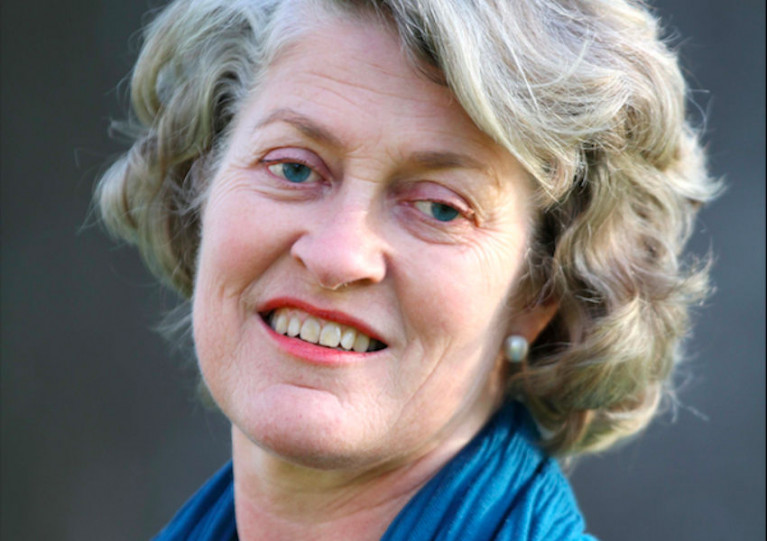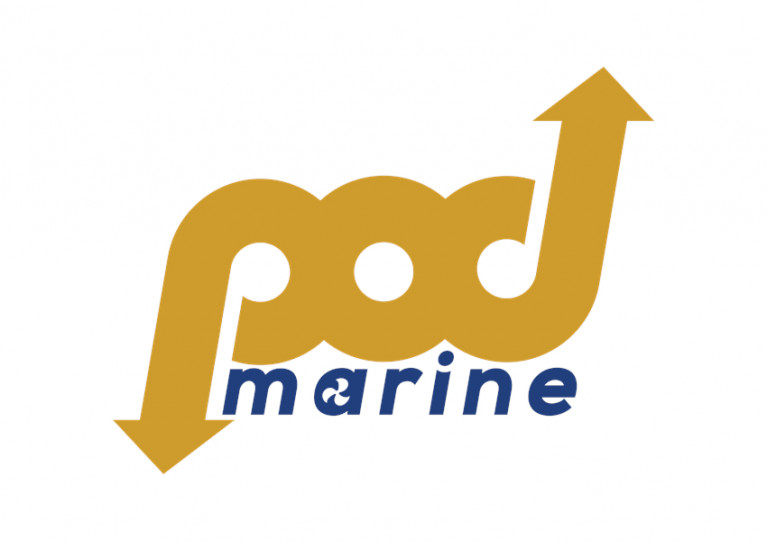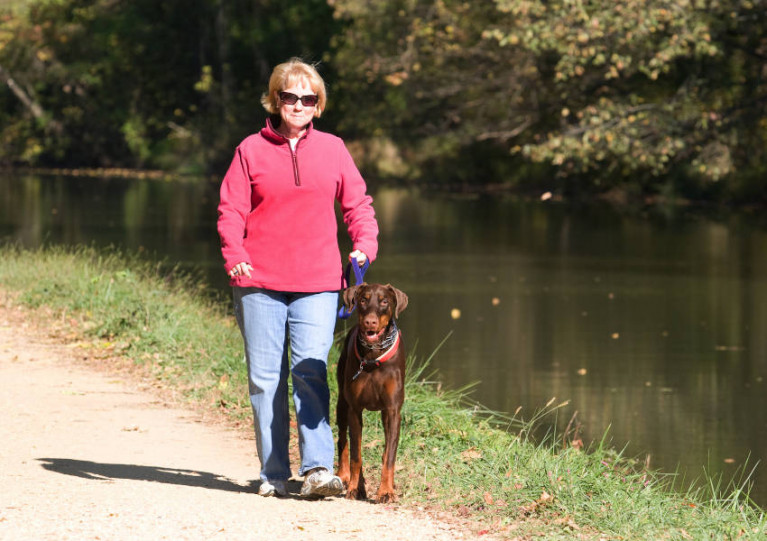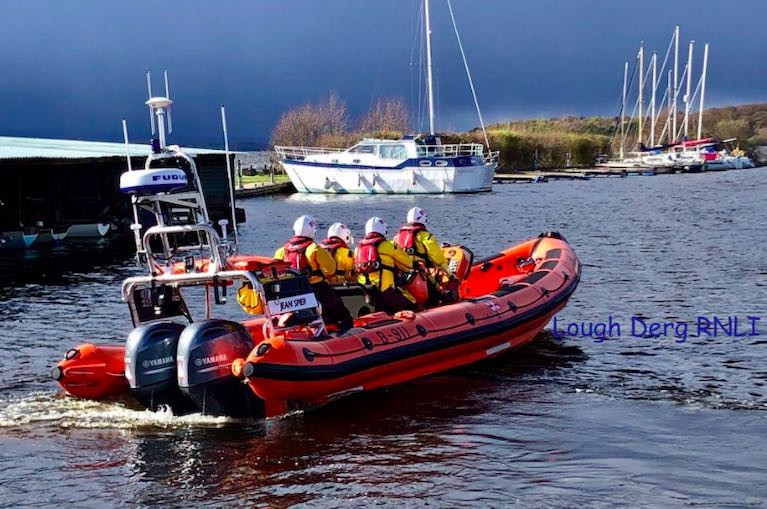Displaying items by tag: Lough Derg
Lough Derg RNLI launched on Wednesday evening (16 June) to assist two people on a 32ft cruiser aground by the entrance to Terryglass Harbour, at the northern end of Lough Derg.
At 6.48pm the inshore lifeboat Jean Spier set off with helm Eleanor Hooker and crew Steve Smyth, Joe O’Donoghue and Tom Hayes on board. Weather conditions had a westerly Force 3/4 wind with good visibility.
The lifeboat arrived on scene 20 minutes later and could see the cruiser aground inside the navigation marker by Terryglass Harbour.
After assessing the location and depths, the lifeboat made a careful approach to the casualty vessel, all the time taking soundings of the depths. Once alongside, the RNLI volunteers found both passengers on board to safe and unharmed and wearing their lifejackets.
A lifeboat crew member transferred across to the cruiser and, after making a thorough check of the boat to ensure it was not holed, set up for a tow.
The lifeboat found the casualty vessel to be stuck fast on the rocky shelf. Two marine engineers from the cruise hire company arrived on scene with a tow vessel but were also unable to get the vessel off the rocks.
The lifeboat took both passengers and their RNLI crew member onto the lifeboat and into Terryglass Harbour, where arrangements were made for both casualties to stay on shore overnight and their boat to be refloated this morning.
Brendan O’Brien, deputy launching authority at Lough Derg RNLI ,advises boat users to “plan your passage, study your charts and identify the navigation marks for the harbour to which you are travelling”.
Lough Derg Lifeboat Launches To Cruiser With Fuel Problems
Lough Derg RNLI’s inshore lifeboat was requested by Valentia Coast Guard to launch to assist four people on a 35ft cruiser with fuel problems yesterday evening, Friday 11 June.
The vessel was reported to be near Navigation Mark F, north of the Goat Road on the Tipperary shore.
At 5.05pm the lifeboat Jean Spier launched with helm Owen Cavanagh and crew Eleanor Hooker, Joe O’Donoghue and Chris Parker on board. Conditions had a westerly Force 3/4 wind, with good visibility.
Fifteen minutes later, the lifeboat located the vessel just off the navigation channel above the Goat Road, where the passengers had dropped anchor to prevent drifting into the shallows and onto rocks.
All on board were found to be safe and unharmed, and wearing their lifejackets.
An RNLI volunteer transferred across the casualty vessel and once it was established that there was no damage to the vessel, but that it would require assistance to safe harbour, an alongside tow was set up.
The nearest safe harbour was the public moorings at Kilgarvan Quay, where the casualty vessel was safety tied at 5.50pm.
Jeremy Freeman, deputy launching authority at Lough Derg RNLI, advises boat users this busy summer season to “ensure you have sufficient, fresh fuel for your journey and a means of communication”.
Lough Derg RNLI launched to assist a person on a 28ft cruiser with engine failure, near Mountshannon on Friday evening.
At 5.58 pm, Valentia Coast Guard requested Lough Derg RNLI lifeboat to launch. At 6.09 pm, the lifeboat Jean Spier launched with helm Eleanor Hooker, crew Joe O’Donoghue, Tom Hayes and Ciara Moylan on board.
The winds were southerly, Force 3/4. Visibility was good.
With a description from the Valentia Coast Guard, the lifeboat located the vessel in the navigation channel off Ilaun Hobert and was alongside at 6.19 pm. The skipper was safe and unharmed and wearing his lifejacket. He had managed to get his engine going and was underway, but at a slow speed, as the engine cut each time he increased the revs.
The lifeboat informed Valentia Coast Guard that they were going to take the casualty vessel under tow to Dromaan Harbour. By Dromaan Harbour the lifeboat volunteers changed the tow from an astern tow to an alongside tow in order to navigate the narrow channel into the Harbour.
At 7.24 pm the casualty vessel was safely tied alongside and the lifeboat departed the scene. The lifeboat was back at the station at 7.40 pm.
Liam Maloney, Deputy Launching Authority at Lough Derg RNLI advises boat users to ‘ensure your boat engine is serviced, and that you use fresh fuel when returning to the water after overwintering your boat’.
Last Sunday morning members of the Lough Derg RNLI Fundraising committee and the Lifeboat station welcomed Joe Barry, uilleann piper and writer, to the Station.
A long time supporter of the RNLI, Joe presented a cheque for €2,600, proceeds from the sales of his third book 'Once Upon a Piper’s Time', to Niamh McCutcheon, Chairperson of the Lough Derg RNLI Fundraising Committee. Joe, whose book was first published in November 2019, had intended to present the cheque in 2020, but the pandemic prevented him doing so. He was accompanied by fellow musicians, Martin Shot and Cillian Roche, from the Thomas MacDonagh Pipe Band.
As a founder member of the Thomas MacDonagh Pipe Band in 1962, Joe and his band have performed around the world. They have played for President Higgins at Áras an Uachtaráin, at the St.Patrick’s Day Parade in New York and at a commemoration ceremony on the beaches at Normandy. Closer to home, Joe, who plays the uilleann and highland pipes, led the Thomas MacDonagh Pipe Band at the opening ceremony for the Mirror World Sailing Championships at Lough Derg Yacht Club.
Joe says he first started fundraising for the RNLI following a Christmas visit to Kilmore Quay twenty-five years ago. He went there to hear the famous Kilmore Carollers and learned that the choir were all volunteers with the Kilmore RNLI lifeboat. After the service, Joe says he was invited by RNLI volunteer, the late Jack Devereux, to see the station and learn about lifeboat launches. He says since that time he has had a ‘deep respect for the brave men and women of the RNLI’.
On behalf of her fundraising committee and all the volunteers at Lough Derg RNLI, Niamh McCutcheon thanked Mr. Barry for his ‘ongoing generosity and support’. Niamh noted that although the pandemic had restricted fundraising activities, the RNLIs lifesaving operations have continued without interruption. Niamh told Joe that his donation-supported ‘volunteers training and equipment, and ensures our crew have the very best kit’ to perform a rescue and to then bring them home safely to their families, whom they must leave every time they respond to a Shout.
Niamh reminded the assembled group that in 2009 Joe donated €3,000 to Lough Derg RNLI; the proceeds from his first book Ate Mate and Follow the Band. Niamh commended Joe’s cousin ‘John Crowe and his wife Phyllis who underwrote the total printing costs of the book and Joe’s previous books so that all funds raised are benefitting the RNLI’. Celebrating a big birthday recently, Joe asked that instead of gifts, friends and family made donations to the RNLI. Niamh has since received a further €100 after another ten copies of the book were sold.
Prior to the presentation, the fundraising committee provided refreshments, with kind permission, on the balcony of Lough Derg Yacht Club. Crew arrived back to station just as the presentation was being made and Joe was delighted to meet the volunteers and to see the lifeboat, Jean Spier, on the water.
RNLI lifeboat volunteers come from a multiplicity of backgrounds. And though some may have no previous maritime experience before they enrol, this is not an issue as the RNLI provide a comprehensive and rigorous programme that equips trainees to meet all necessary requirements to be crew on a lifeboat. Being an RNLI lifeboat crew is one of the most exciting and fulfilling roles a person can perform; it offers volunteers the opportunity to make a difference in their local community, to save lives, and to be part of an inclusive and diverse organisation.
Stephen Seymour is a dairy farmer who lives and farms close to Dromineer. He says, having a greater amount of free time, he decided to find out more about joining the lifeboat crew. Stephen says that a strong impetus for him to volunteer with the RNLI, was the ‘opportunity it would provide to save lives on the lake’.
Ania Skrzypczynska, a graphic designer, moved to Dromineer a year ago. She says following encouragement from her neighbour, Eleanor Hooker, a volunteer helm at the station, she decided to visit the station and to find out what volunteering with the lifeboat would entail. Ania says ‘boating is very new to me and lifeboating is certainly not something I was familiar with, however, it sounded like an exciting adventure’ with the chance to learn new skills. Even though initially she says she was a ‘bit apprehensive about this big commitment’, she’s glad she’s joined the crew and hopes to be able to ‘make a positive impact in someone’s life’.
Ciara Moylan, a Rooms Division Manager at the Abbey Court Hotel in Nenagh, lives in Dromineer village. She says ‘living so close to a lifeboat station and growing up on the lake, it's always something I've wanted to be a part of’. Of her experience as an RNLI volunteer thus far, Ciara says it’s ‘extremely rewarding and I am very grateful to be part of this organization and having access to all of the knowledge I've already received and will continue to receive’.
Richard Nolan runs a Consulting Business. He says after ‘moving home from London, I was excited to get involved in various local causes’ to help where he could and to get to know local people having been away for so long. Richard says that living by the lake, he was ‘particularly excited to see positions advertised with the RNLI’ as it presented him with the opportunity to support his community and also to get to know the lake. Of his initial training over the past few months, Richard says he recognised ‘this wasn’t going to be an average volunteering opportunity’ but says that the ‘team have all been phenomenally supportive’.
Dom Sharkey, a senior helm at the station says it’s ‘great to see local men and women volunteer for the lifeboat, I’m delighted to welcome our four enthusiastic new recruits to the Lough Derg RNLI crew’.
Lough Derg RNLI Lifeboat Assists 20ft Motorboat with Engine Failure South of the Scilly Islands
At 11.30 am today, Sunday 25 April, whilst out on exercise, Lough Derg RNLI volunteers in County Tipperary noticed the passengers of a 20ft motorboat waving to them to signal their distress.
The motorboat was south of the Scilly Islands and lying side on to the weather. The wind was easterly, F3, with good visibility.
The lifeboat, with helm Eleanor Hooker, Joe O’Donoghue, Chris Parker and Ania Skrzypczynska on board, immediately made way to the vessel. The two people on board the casualty vessel asked for assistance as their boat had suffered engine failure.
The lifeboat informed the Valentia Coast Guard of the situation. The crew set up an astern tow to take the vessel with her passengers back to Garrykennedy Harbour, the closest available safe harbour, and from where they had started their journey.
At 12.13 pm the casualty vessel was safely tied alongside at Garrykennedy Harbour. At 12.18 pm Lough Derg RNLI lifeboat, Jean Spier, departed the scene to return to station.
Lough Derg RNLI have announced the appointment of Dr Christine O’Malley as lifeboat operations manager.
Dr O’Malley, who took up the post on 8 January this year after the retirement of Liam Maloney, is now responsible for all activities at the lifeboat station on the Shannon Navigation.
The retired consultant geriatrician, and regular columnist for the Medical Independent, joined Lough Derg RNLI in 2019 as a volunteer deputy launching authority — a role that she now hands over to Maloney.
In her new position, Dr O’Malley is receiving support and guidance from Owen Medland, RNLI regional lifesaving lead for Ireland; Peter Harty, RNLI area lifesaving manager for the East of Ireland, and RNLI crew assessor trainer Helena Duggan, as well as the dedicated volunteers at Lough Derg RNLI.
“Already a highly respected member of the station, Christine brings a wealth of leadership and management experience from her medical career,” Harty says.
“Christine has come onboard as we progress towards a year in which we anticipate a high volume of ‘staycationers’ enjoying Lough Derg.”
Lough Derg RNLI operates from the premises of Lough Derg Yacht Club at Dromineer, midway down the east shore of the lake in Co Tipperary.
Lough Derg’s Shannon Sailing Ltd Acquired by POD Marine
Dun Laoghaire Harbour-based POD Marine Ltd recently announced the acquisition of Lough Derg boating firm Shannon Sailing Ltd.
The deal involved the transfer of an 80-plus-berth, private and enclosed marina with swinging moorings, chandlery and engineering workshop based on the inland waterway in the village of Dromineer, Co Tipperary.
Equipment in the purchase includes a hydraulic crane for smaller loads and a 35-ton boat lift for larger vessels.
The site also comprises a private car park, slipway, diesel pump and pump-out facilities.
As with its base at Dun Laoghaire’s West Pier, POD Marine says the site in Dromineer has ample space for boat and trailer storage.
The company also confirms that the Dromineer business will continue as an ongoing concern.
Proposal for ‘Shannon Greenway’ to Connect Limerick with Lough Derg
A working group has been established to develop a proposal for a Shannon Greenway connecting the city of Limerick with Lough Derg.
Waterways Ireland says it is working together with Clare County Council, Limerick City & County Council and others on the plans, which are still at an early concept stage.
However, it is understood that the working group has already been charged with examining possible route options and designs, as well as environmental considerations, costs and funding sources.
Also being considered is whether public lands between Limerick and Tuamgraney/Scarriff in Co Clare — especially the towpaths of the Park and Erinagh Canals and various ESB embankments — could be used for the project.
Lough Derg RNLI Feature on BBC TV Series 'Saving Lives at Sea'
The volunteer lifeboat crew at Lough Derg RNLI will be taking to the small screen again on Tuesday 17 November at 8 pm, as they feature in the seventh episode of the BBC TV series Saving Lives at Sea.
Real-life rescue footage captured on their helmet cameras gives a frontline view of how the charity’s lifesavers risk their own lives as they go to the aid of those in danger at sea and strive to save everyone.
Now in its fifth series, the 10-part documentary showcases the lifesaving work of the RNLI’s volunteer lifeboat crews and lifeguards from around Ireland and the UK. The series will air on BBC Two on Tuesdays at 8 pm, as well as being available on BBC iPlayer following broadcast.
Real rescue footage is accompanied by interviews from the volunteer lifeboat crews and lifeguards alongside the people they rescue and their families.
In a forthcoming episode, to be aired on Tuesday 17 November at 8 pm on BBC Two, viewers will see Lough Derg RNLI rescue two kayakers who got into extreme difficulty in rough weather, alongside rescue stories from their colleagues at other stations and beaches around our coasts.
Owen Cavanagh, Helm of the Lough Derg RNLI lifeboat crew featured in the 17 November episode, says: ‘It’s great that with the Saving Lives at Sea programme our supporters can see what we do out on a Shout, and from the comfort of their own home too. This year the pandemic has presented RNLI volunteers with additional challenges, but we’ve continued to maintain a 24/7 search and rescue service. And due to Covid19, fundraising events have been cancelled, with a drop in our charitable income. Without the generous support and donations from the public, we wouldn’t be able to save lives at sea. We need their support more than ever during these challenging
times.’
During 2019, RNLI lifeboat crews around Ireland and the UK rescued
- 9,412 people, saving 211
- lives, while the charity’s lifeguards aided
- 32,207 people and saved 118
- lives on some of the UK’s busiest beaches.
































































